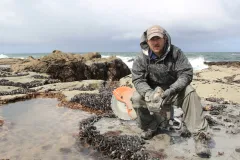Dispatches from the Field: Treacherous stream crossings and a new fossil find

We departed from Port Renfrew on Tuesday morning on the Michelle Diana, a boat chartered specifically for our expedition. An hour later we approached Carmanah Point, a tall cliff upon which the Carmanah lighthouse sits (built in 1891). We made the treacherous boat-shore transition in the rain with assistance from Parks Canada's wardens, and then organized our dozen bags of gear to begin work. It was exhilarating to finally set foot on land; this is a remote place.
It is a 3 km hike along the famed West Coast Trail from the lighthouse. Most of the walk is picturesque, postcard British Columbia West Coast, but to reach our site we needed to ford Carmanah Creek. At low tide the creek is passable by knee high, ice-cold water; anything higher, and we need to use the cable car, an aluminum basket slung 200 feet across the creek on a steel cable with a pull rope. Most of the time we haul gear above our heads across the creek or in the cart, Oregon Trail-style.
Our site sits on a flat rocky platform that extends into the surf. We can only dig at low tide, so plan each day according to the tides to maximize our time on site. To speed things up, we brought the largest hand-held rock saw available (16 inch, diamond blade). We're working in some of the toughest rock to retrieve whale fossils -- mudstones -- so hammer and chisels are used strategically. It would be soul-sapping without the saw.
Some great news: on our first day, we confirmed a second whale fossil a few dozen meters away. (Janet Etzkorn, the lighthouse keeper's wife, discovered it). It's another skull of the same kind of "toothed" mysticete, but clustered very tightly with its jaws, loose teeth and vertebrae, ideal for a block extraction. Via our Parks handlers, we completed an emergency emendation to our permit, and now we're half-way through excavating both whale skeletons.
Although a few squalls occasionally blow through, we have generally had excellent weather and everyone is in great spirits. Our work is brutally hard, but the views and camaraderie help. Liz Nesbitt of the Burke Museum has been working on the geological context of the site, and discovered evidence for a fossil methane seep -- a deep sea gas deposit -- nearby. At the end of the day, we collected our thoughts in the warm afternoon light atop Carmanah Point, with the edge of the Olympic Peninsula in Washington State to the south, and the long West Coast running into the sea. This is fun stuff. More soon.
Editor's note: Read Nick's first blog post about "toothed" baleen whales to see what their team is excavating on Vancouver Island.

